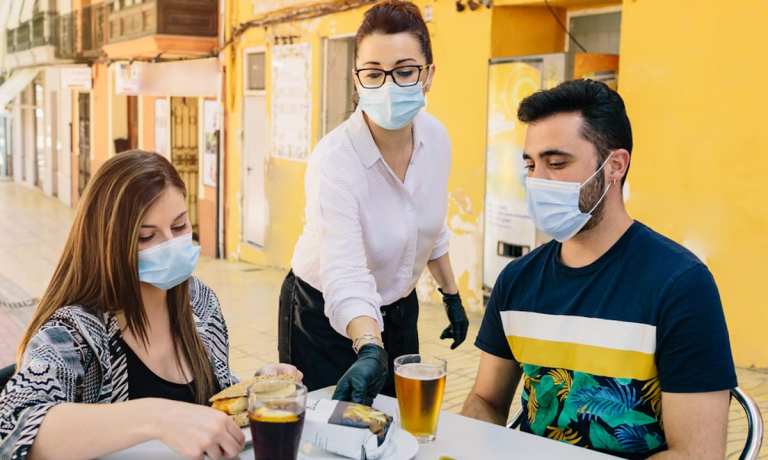New Findings Indicate Cause For Hope In Restaurant Industry

After an extremely difficult year for restaurants, with both local businesses and international chains seeing sales declines and store closures, there may be some optimism returning to the industry. Yelp data indicate that 2020’s fourth quarter showed a return to growth, with 18,207 new restaurants opening in the United States, just a 4 percent decrease from Q4 2019. In fact, grab-and-go food vendor openings increased year over year, with a significant number of new food trucks and bakeries, among others.
These openings may seem like an odd choice, as COVID-19 cases continue to surge and the industry remains in flux, but there are certain advantages to introducing a new eatery right now. “First of all, there isn’t much ‘newness’ in the industry, and a new market entrant could offer differentiation and excitement for consumers who are relatively pessimistic right now,” Joe Pawlak, managing principal of food insights consultancy Technomic, said to Restaurant Business in July. “A new restaurant opening in this environment is news in and of itself.”
New York restaurant group Major Food Group, for example, recently expanded its Michelin-starred Carbone raw bar restaurant to Miami, Florida, reported luxury magazine Robb Report. The outpost features interiors by celebrity designer Ken Fulk and uniforms designed by fashion magnate Zac Posen, and artwork selected by star art dealer Vito Schnabel. Major Food Group is also planning to open luxury French, Japanese and Italian restaurants in Miami in the near future.
“We brought down an incredible squad,” Carbone’s chef Mario Carbone told the magazine. “We joke that it’s Ocean’s 11. It’s basically one person per micro-department, everyone from management to somm team, captains, back waiters, runners, chefs, pastry chefs and bakers. I think it actually is 11 people we brought down. A lot of them have been with us since almost day 1, so they’re coming up on a decade with us.”
Yelp also reported that 3,512 restaurants reopened during the quarter. New technological innovations may be helping restaurants gain confidence in their ability to open or reopen. The first virtual kitchen franchise, The Local Culinary, which launched its franchise opportunity in October, now has 50 virtual restaurants and gains more each month, according to a recent company news release. “This is a simple operation, it’s profit-driven, and it’s adaptable to existing restaurants,” said Owner and Founder Alp Franko. “Since an existing kitchen already has their overhead costs fixed, adding one of our brands simply brings additional revenue.”
Just before the start of the quarter, we noted that initial applications for employee identification numbers (among the initial applications to get businesses up and running) were up at a pace not seen in more than a decade. In our August six-month Main Street SMB checkpoint, a full 24 percent of respondents said they had seen an actual improvement in their financial situation since March, and 65 percent said their financial status remained the same. Among the more optimistic of verticals: 61 percent of restaurants stated they were not at risk of closing before the pandemic runs its course. Drilling down a bit, as many as 27.8 percent of restaurants said their fortunes had improved. Part of that survival comes from the digital shift, but the optimism comes, too, as restaurants await pent-up demand when it’s again safe to congregate at tables.
Of course, it’s too soon to say whether these restaurants’ optimism is well-founded. In December, our research found that 60 percent of operators of small restaurants (with less than $250,000 in AUV) have had their revenues decline since the pandemic began. Restaurants with more than $1 million in AUV have managed to weather this financial storm more effectively, as only 32 percent have seen their revenues decrease since the pandemic began.
However, mobile ordering technology has provided hope: More than half of restaurants that have experienced revenue increases have benefited from a surge in mobile ordering, our researchers found. Ninety-two percent of top performers provided mobile order-ahead options, and an equally large share also offered loyalty programs.
Additionally, this month’s Delivering on Restaurant Rewards report found that consumers spend 50 percent more on average when they place orders online for takeout. Sit-down restaurant customers who order food for takeout spend $43 more per month than those who dine on-site. Plus, restaurant customers who belong to loyalty programs spend twice as much as those who do not.
So, though the restaurant industry still has an uphill battle ahead, there is cause to hope. New openings and new technologies provide a glimpse into a future that, just months ago, was nearly impossible to imagine.
Read More On Restaurants:
- Domino’s Loyalty Refresh Doubles Members’ Pickup Orders Amid Consumer Hesitance
- Gen Z Diners Fall Behind Baby Boomers in Restaurant Spending
- Starbucks Launches EV Charging Partnership With Mercedes
- OpenTable and Visa Launch Restaurant Reservation Partnership